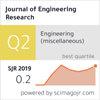An integration of PSO-ANN and ANFIS hybrid models to predict surface quality, cost, and energy (QCE) during milling of alloy 2017A
IF 0.9
4区 工程技术
Q3 ENGINEERING, MULTIDISCIPLINARY
引用次数: 0
Abstract
An alarming pace of increase in worldwide energy consumption is being caused by population expansion and economic development, particularly in emerging market countries. Due to their efficiency and reproducibility in accomplishing high-precision machining, CNC machine tools are widely employed in most metal machining processes. The use of simple machining features to search for the assignment of cutting parameters and the machining process on the output variables is limited since a part, in reality, can contain complex interacting features. Therefore, this study focuses on pocket/groove features by integrating grey relational analysis (GRA) and hybrid PSO-ANN and ANFIS algorithms to optimize and predict surface quality, cost and energy consumption (QCE). Taking into account the population size of the swarm (pop) and the number of neurons (n) in the hidden layer, a parametric study was carried out to find the best prediction using the hybrid algorithm PSO-ANN. This study reported the highest trained correlation values (R2) for all output variables (greater than 0.97%). The study shows that the assignment of machining strategies and sequences on energy consumption can reach 99.25% between the minimum and maximum values. The mean square error (MSE) data demonstrates that the PSO-ANN model is effective. Indeed, an MSE improvement of 99.84%, 99.87%, and 97.62% has been demonstrated in terms of Etot, Ctot, and Ra, respectively, of the PSO-ANN model compared to ANFIS. This study reveals the potential of the PSO-ANN hybrid for multi-criteria prediction (quality, cost, and energy: QCE) by comparing it with the ANFIS model.
结合PSO-ANN和ANFIS混合模型预测合金2017A铣削过程中的表面质量、成本和能量(QCE)
由于人口增长和经济发展,特别是在新兴市场国家,全球能源消费正以惊人的速度增长。由于数控机床在实现高精度加工方面的高效性和可重复性,在大多数金属加工过程中得到了广泛的应用。由于零件在现实中可能包含复杂的相互作用特征,因此使用简单的加工特征来搜索切削参数的分配和加工过程对输出变量的影响是有限的。因此,本研究主要通过灰色关联分析(GRA)和混合粒子群神经网络(PSO-ANN)和ANFIS算法来优化和预测表面质量、成本和能耗(QCE)。考虑到群体的总体大小(pop)和隐藏层的神经元数量(n),采用PSO-ANN混合算法进行参数化研究,寻找最佳预测结果。本研究报告了所有输出变量的最高训练相关值(R2)(大于0.97%)。研究表明,加工策略和顺序对能耗的分配在最小值和最大值之间可达99.25%。均方误差(MSE)数据表明PSO-ANN模型是有效的。事实上,与ANFIS相比,PSO-ANN模型的Etot、Ctot和Ra的MSE分别提高了99.84%、99.87%和97.62%。本研究通过与ANFIS模型进行比较,揭示了PSO-ANN混合模型在多准则预测(质量、成本和能量:QCE)方面的潜力。
本文章由计算机程序翻译,如有差异,请以英文原文为准。
求助全文
约1分钟内获得全文
求助全文
来源期刊

Journal of Engineering Research
ENGINEERING, MULTIDISCIPLINARY-
CiteScore
1.60
自引率
10.00%
发文量
181
审稿时长
20 weeks
期刊介绍:
Journal of Engineering Research (JER) is a international, peer reviewed journal which publishes full length original research papers, reviews, case studies related to all areas of Engineering such as: Civil, Mechanical, Industrial, Electrical, Computer, Chemical, Petroleum, Aerospace, Architectural, Biomedical, Coastal, Environmental, Marine & Ocean, Metallurgical & Materials, software, Surveying, Systems and Manufacturing Engineering. In particular, JER focuses on innovative approaches and methods that contribute to solving the environmental and manufacturing problems, which exist primarily in the Arabian Gulf region and the Middle East countries. Kuwait University used to publish the Journal "Kuwait Journal of Science and Engineering" (ISSN: 1024-8684), which included Science and Engineering articles since 1974. In 2011 the decision was taken to split KJSE into two independent Journals - "Journal of Engineering Research "(JER) and "Kuwait Journal of Science" (KJS).
 求助内容:
求助内容: 应助结果提醒方式:
应助结果提醒方式:


